Recycling Pig Slurry Solid Fraction Compost as a Sound Absorber
Abstract
:1. Introduction
2. Materials and Methods
2.1. Composting Trial
2.2. Particle Size Distribution
2.3. Bulk Density
2.4. Densification Equipment and Sample Preparation
2.5. Durability
2.6. Impedance Tube Device and Acoustical Test
2.7. Data Analysis
3. Results
3.1. Particle Size Distribution
3.2. Compact Density
3.3. Durability
3.4. Measuring the Acoustic Absorption Coefficient
4. Discussion
5. Conclusions
Author Contributions
Conflicts of Interest
References
- Arenas, J.P.; Crocker, M.J. Recent trends in porous sound absorbing materials for noise control. J. Sound Vib. 2010, 44, 12–17. [Google Scholar]
- Glé, P.; Gourdon, E.; Arnaud, L. Acoustical properties of materials made of vegetable particles with several scales of porosity. Appl. Acoust. 2011, 72, 249–259. [Google Scholar] [CrossRef]
- Oldham, D.J.; Egan, C.A.; Cookson, R.D. Sustainable acoustic absorbers from the biomass. Appl. Acoust. 2011, 72, 350–353. [Google Scholar] [CrossRef]
- Berardi, U.; Iannace, G. Acoustic characterization of natural fibers for sound absorption applications. Build. Environ. 2015, 94, 840–852. [Google Scholar] [CrossRef]
- Fouladi, M.H.; Nor, M.J.M.; Ayub, M.; Leman, Z.A. Utilization of coir fiber in multilayer acoustic absorption pane. Appl. Acoust. 2010, 71, 241–249. [Google Scholar] [CrossRef]
- Bansod, P.V.; Mohanty, A.R. Inverse acoustical characterization of natural jute sound absorbing material by the particle swarm optimization method. Appl. Acoust. 2016, 112, 41–52. [Google Scholar] [CrossRef]
- Gori, P.; Guattari, C.; Asdrubali, F.; de Lieto Vollaro, R.; Monti, A.; Ramaccia, D.; Bilotti, F.; Toscano, A. Sustainable Acoustic Metasurfaces for Sound Control. Sustainability 2016, 8, 107. [Google Scholar] [CrossRef]
- Pampuro, N.; Facello, A.; Cavallo, E. Pressure and specific energy requirements for densification of compost derived from swine solid fraction. Span. J. Agric. Res. 2013, 11, 678–684. [Google Scholar] [CrossRef]
- United States International Trade Commission. Pork and Swine. Industry & Trade Summary. 2014; Publication ITS-11. Available online: http://www.usitc.gov/publications/332/pork_and_swine_summary_its_11.pdf (accessed on 20 September 2017).
- Segat, J.C.; Alves, P.R.L.; Baretta, D.; Cardoso, E.J.B.N. Ecotoxicological evaluation of swine manure disposal on tropical soils in Brazil. Ecotoxicol. Environ. Saf. 2015, 122, 91–97. [Google Scholar] [CrossRef] [PubMed]
- Marquer, P.; Rabade, T.; Forti, R. Pig Farming Sector—Statistical Portrait 2014. Statistics in Focus. ISSN: 2314-9647. Available online: http://ec.europa.eu/eurostat/statistics-explained/index.php/Pig_farming_sector-statistical_portrait_2014 (accessed on 21 September 2017).
- Chen, K.; Wang, J. Hog farming in transition: The case of China. In Asian Livestock Challenges Opportunities and Responses, Proceedings of the International Policy Forum, Bangkok, Thailand, 16–17 August 2012; Food and Agriculture Organization of the United Nations (FAO): Rome, Italy, 2012. [Google Scholar]
- Italian National Statistical Institute (ISTAT). Farm Structure Survey—Year 2013; ISTAT: Rome, Italy, 2015; Available online: http://censimentoagricoltura.istat.it (accessed on 20 September 2017).
- Pampuro, N.; Dinuccio, E.; Balsari, P.; Cavallo, E. Gaseous emissions and nutrient dynamics during composting of swine solid fraction for pellet production. Appl. Math. Sci. 2014, 8, 6459–6468. [Google Scholar] [CrossRef]
- Miner, J.R. Alternatives to minimize the environmental impact of large swine production units. J. Anim. Sci. 1999, 77, 440–444. [Google Scholar] [CrossRef] [PubMed]
- Hirel, B.; Tétu, T.; Lea, P.J.; Dubois, F. Improving Nitrogen Use Efficiency in Crops for Sustainable Agriculture. Sustainability 2011, 3, 1452–1485. [Google Scholar] [CrossRef]
- Troy, S.M.; Lawlor, P.G.; O’Flynn, C.J.; Healy, M.G. Impact of biochar addition to soil on greenhouse gas emissions following pig manure application. Soil Biol. Biochem. 2013, 60, 173–181. [Google Scholar] [CrossRef]
- Vazquez, M.A.; De La Varga, D.; Plana, R.; Soto, M. Integrating liquid fraction of pig manure in the composting process for nutrient recovery and water re-use. J. Clean. Prod. 2015, 104, 80–89. [Google Scholar] [CrossRef]
- Fangueiro, D.; Senbayran, M.; Trindade, H.; Chadwick, D. Cattle slurry treatment by screw press separation and chemically enhanced settling: Effect on greenhouse gas emissions after land spreading and grass yield. Bioresour. Technol. 2008, 99, 7132–7142. [Google Scholar] [CrossRef] [PubMed]
- Hanserud, O.S.; Lyng, K.-A.; Vries, J.W.D.; Øgaard, A.F.; Brattebø, H. Redistributing Phosphorus in Animal Manure from a Livestock-Intensive Region to an Arable Region: Exploration of Environmental Consequences. Sustainability 2017, 9, 595. [Google Scholar] [CrossRef]
- Kaliyan, N.; Vance Morey, R. Factors affecting strength and durability of densified biomass products. Biomass Bioenergy 2009, 33, 337–359. [Google Scholar] [CrossRef]
- Alemi, H.; Kianmehr, M.H.; Borghaee, A.M. Effect of pellet processing of fertilizer on slow-release nitrogen in soil. Asian J. Plant Sci. 2010, 9, 74–80. [Google Scholar] [CrossRef]
- Pampuro, N.; Dinuccio, E.; Balsari, P.; Cavallo, E. Evaluation of two composting strategies for making pig slurry solid fraction suitable for pelletizing. Atmos. Pollut. Res. 2016, 7, 288–293. [Google Scholar] [CrossRef]
- Bernal, M.P.; Alburquerque, J.A.; Moral, R. Composting of animal manures and chemical criteria for compost maturity assessment: A review. Bioresour. Technol. 2009, 100, 5444–5453. [Google Scholar] [CrossRef] [PubMed]
- Zafari, A.; Kianmehr, M.H. Effect of temperature, pressure and moisture content on durability of cattle manure pellet in open-end die method. J. Agric. Sci. 2012, 5, 203–208. [Google Scholar] [CrossRef]
- Jiang, L.; Liang, J.; Yuan, X.; Li, H.; Li, C.; Xiao, Z.; Huang, H.; Wang, H.; Zeng, G. Co-pelletization of sewage sludge and biomass: The density and hardness of pellet. Bioresour. Technol. 2014, 166, 435–443. [Google Scholar] [CrossRef] [PubMed]
- Carone, M.T.; Pantaleo, A.; Pellerano, A. Influence of process parameters and biomass characteristics on the durability of pellets from the pruning residues of Olea europea L. Biomass Bioenergy 2011, 35, 402–410. [Google Scholar] [CrossRef]
- Castellano, J.M.; Gomez, M.; Fernandez, M.; Esteban, L.S.; Carrasco, J.E. Study on the effects of raw materials composition and pelletization conditions on the quality and properties of pellets obtained from different woody and non woody biomasses. Fuel 2015, 139, 629–636. [Google Scholar] [CrossRef]
- Bernhart, M.; Fasina, O.O. Moisture effect on the storage, handling and flow properties of poultry litter. Waste Manag. 2009, 29, 1392–1398. [Google Scholar] [CrossRef] [PubMed]
- Adapa, P.; Tabil, L.; Schoenau, G. Compaction characteristics of barley, canola, oat and wheat straw. Biosyst. Eng. 2009, 204, 335–344. [Google Scholar] [CrossRef]
- American Society of Agricultural and Biological Engineers (ASABE). ASAE S358.2—Moisture Measurement—Forages. In American Society of Agricultural and Biological Engineers Standards; ASABE: St. Joseph, MI, USA, 2006; p. 608. [Google Scholar]
- Li, Y.; Liu, H. High-pressure densification of wood residues to form an upgraded fuel. Biomass Bioenergy 2000, 19, 177–186. [Google Scholar] [CrossRef]
- Mani, S.; Tabil, L.G.; Sokhansanj, S. Specific energy requirement for compacting corn stover. Bioresour. Technol. 2006, 30, 648–654. [Google Scholar] [CrossRef] [PubMed]
- Obernberger, I.; Thek, G. Physical characterization and chemical composition of densified biomass fuels with regard to their combustion behavior. Biomass Bioenergy 2004, 27, 653–669. [Google Scholar] [CrossRef]
- Allaire, S.E.; Parent, L.E. Physical properties of granular organic-based fertilizers, Part 1: Static properties. Biosyst. Eng. 2004, 87, 79–87. [Google Scholar] [CrossRef]
- American Society of Agricultural and Biological Engineers (ASABE). ASAE S269.4—Cubes, pellets, and crumbles—Definitions and methods for determining density, durability, and moisture content. In American Society of Agricultural and Biological Engineers Standards; ASABE: St. Joseph, MI, USA, 2006; p. 608. [Google Scholar]
- Zafari, A.; Kianmehr, M.H. Application of densification process in organic waste management. Waste Manag. Res. 2013, 31, 684–691. [Google Scholar] [CrossRef] [PubMed]
- International Organization for Standardization. ISO 10534-2; Acoustics. Determination of Sound Absorption Coefficient and Impedance in Impedance Tubes—Part 2: Transfer-Function Method; ISO: Geneva, Switzerland, 1998. [Google Scholar]
- Ruiz Celma, A.; Cuadros, F.; Lopez-Rodriguez, F. Characterization of pellets from industrial tomato residues. Food Bioprod. Process. 2012, 90, 700–706. [Google Scholar] [CrossRef]
- Adapa, P.K.; Schoenau, G.J.; Tabil, L.G.; Sokhansanj, S.; Crear, B.J. Pelleting of Fractionated Alfalfa Products; ASABE Pap. No. 036069; ASABE: St. Joseph, MI, USA, 2003. [Google Scholar]
- Zhou, B.; Ileleji, K.E.; Ejeta, G. Physical property relationships of bulk corn stover particles. Am. Soc. Agric. Biol. Eng. 2008, 51, 581–590. [Google Scholar] [CrossRef]
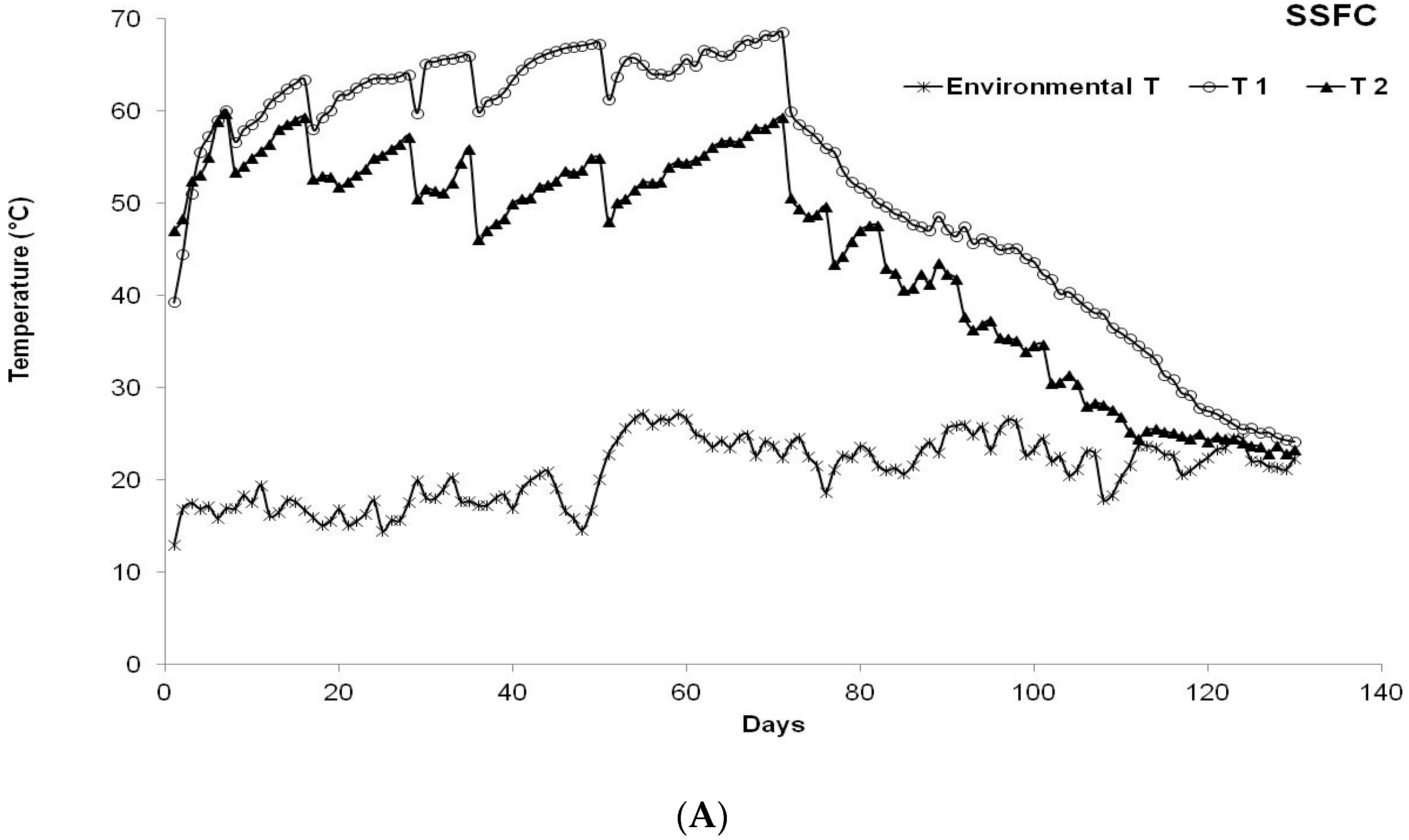
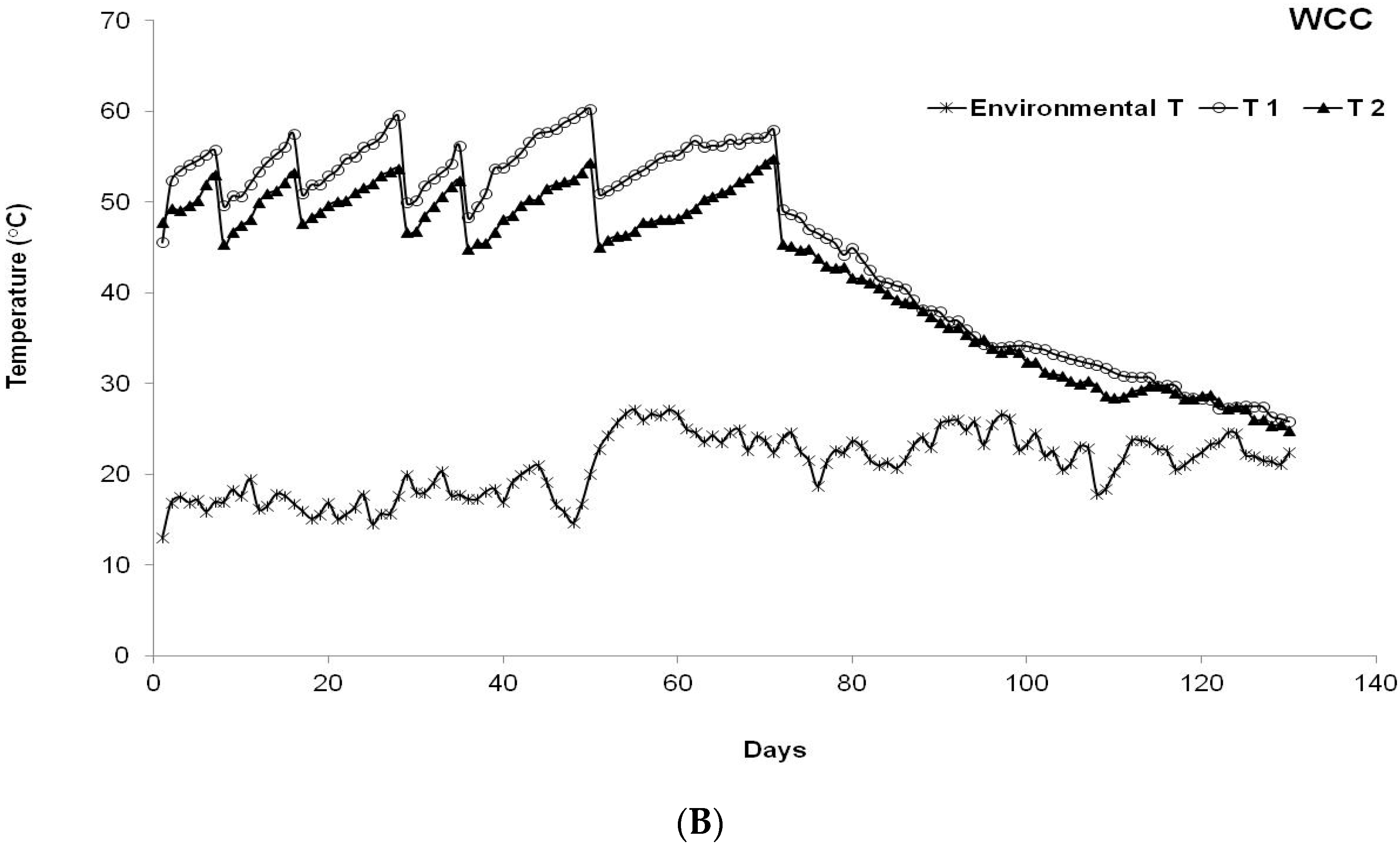

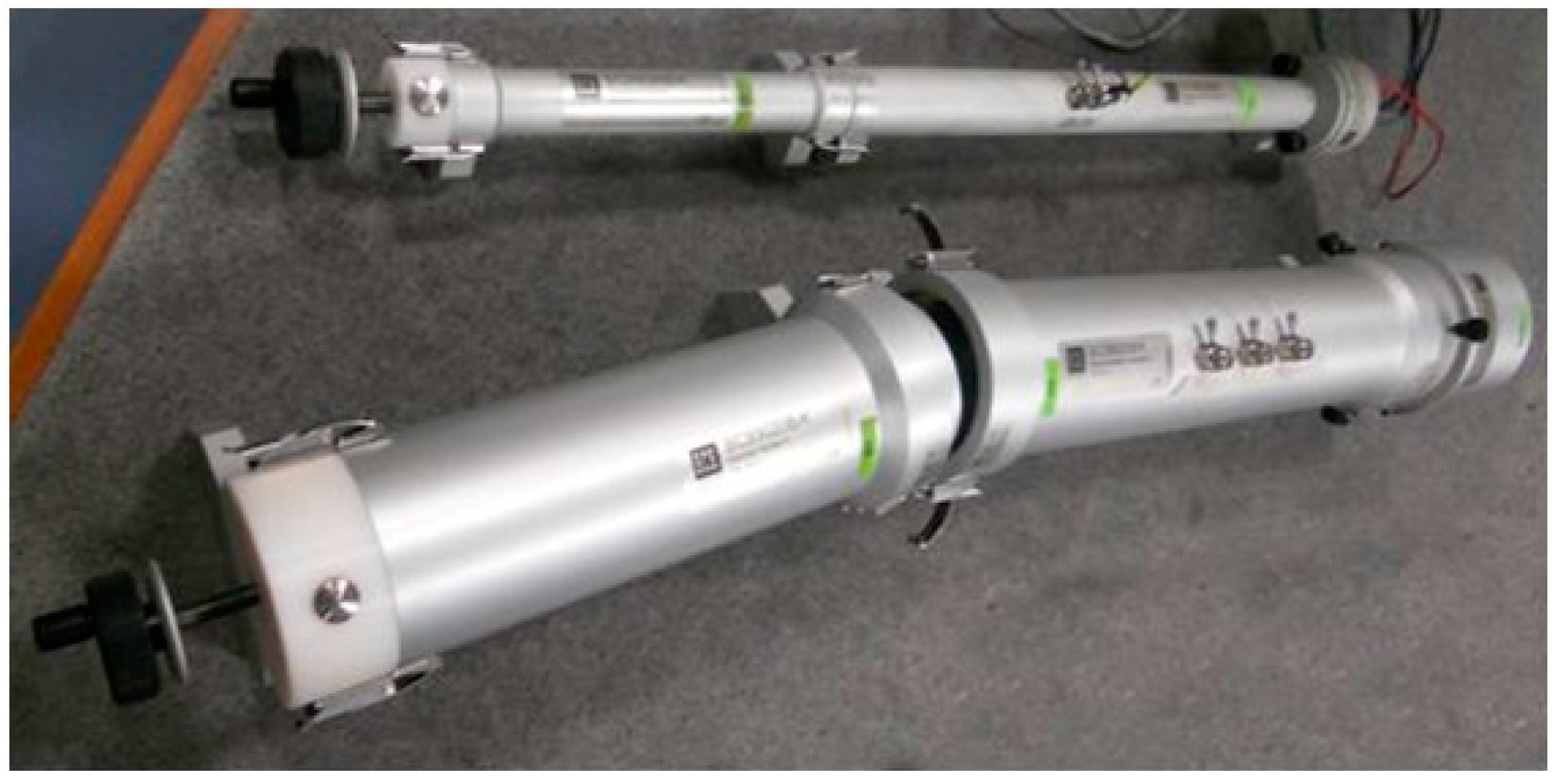
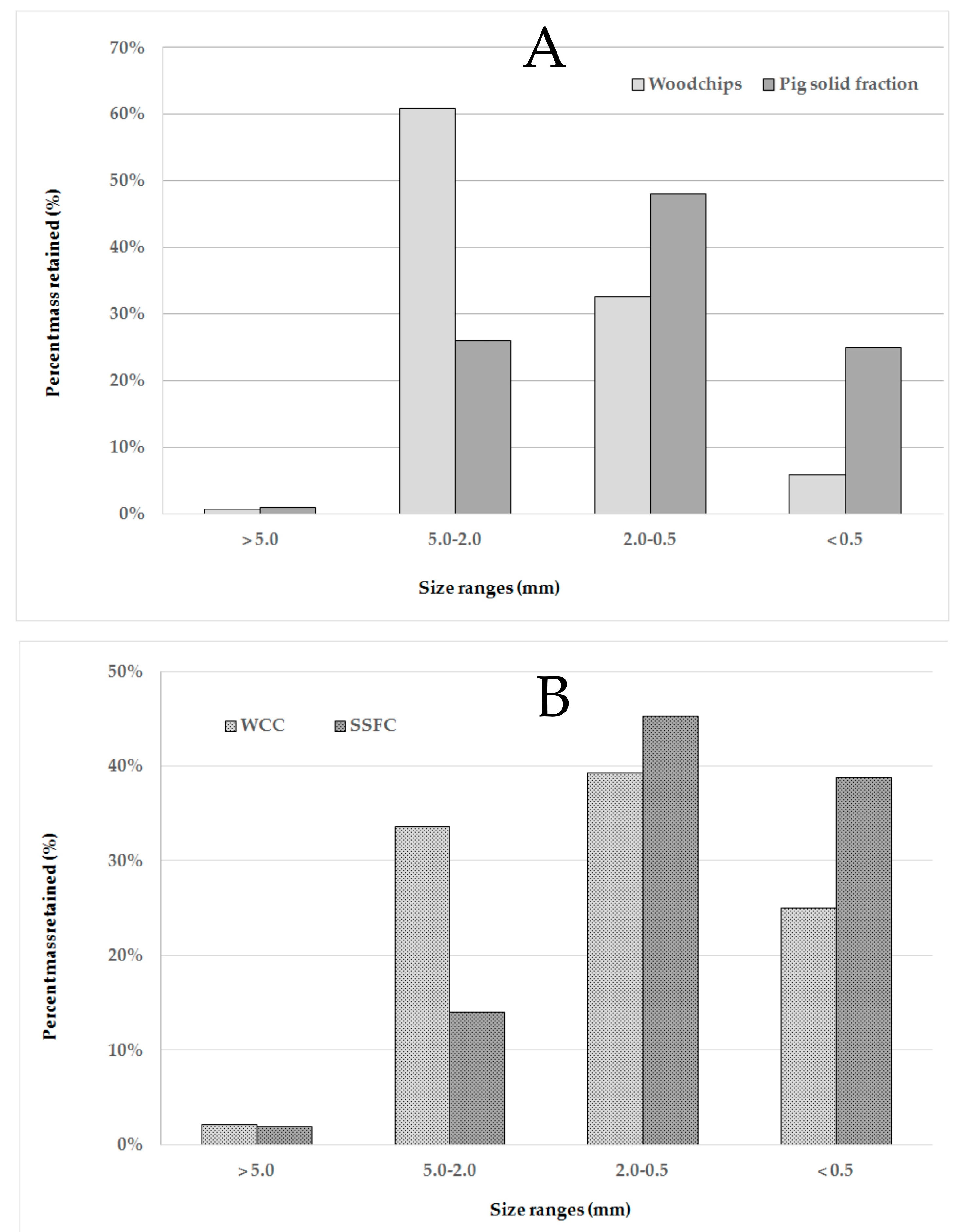
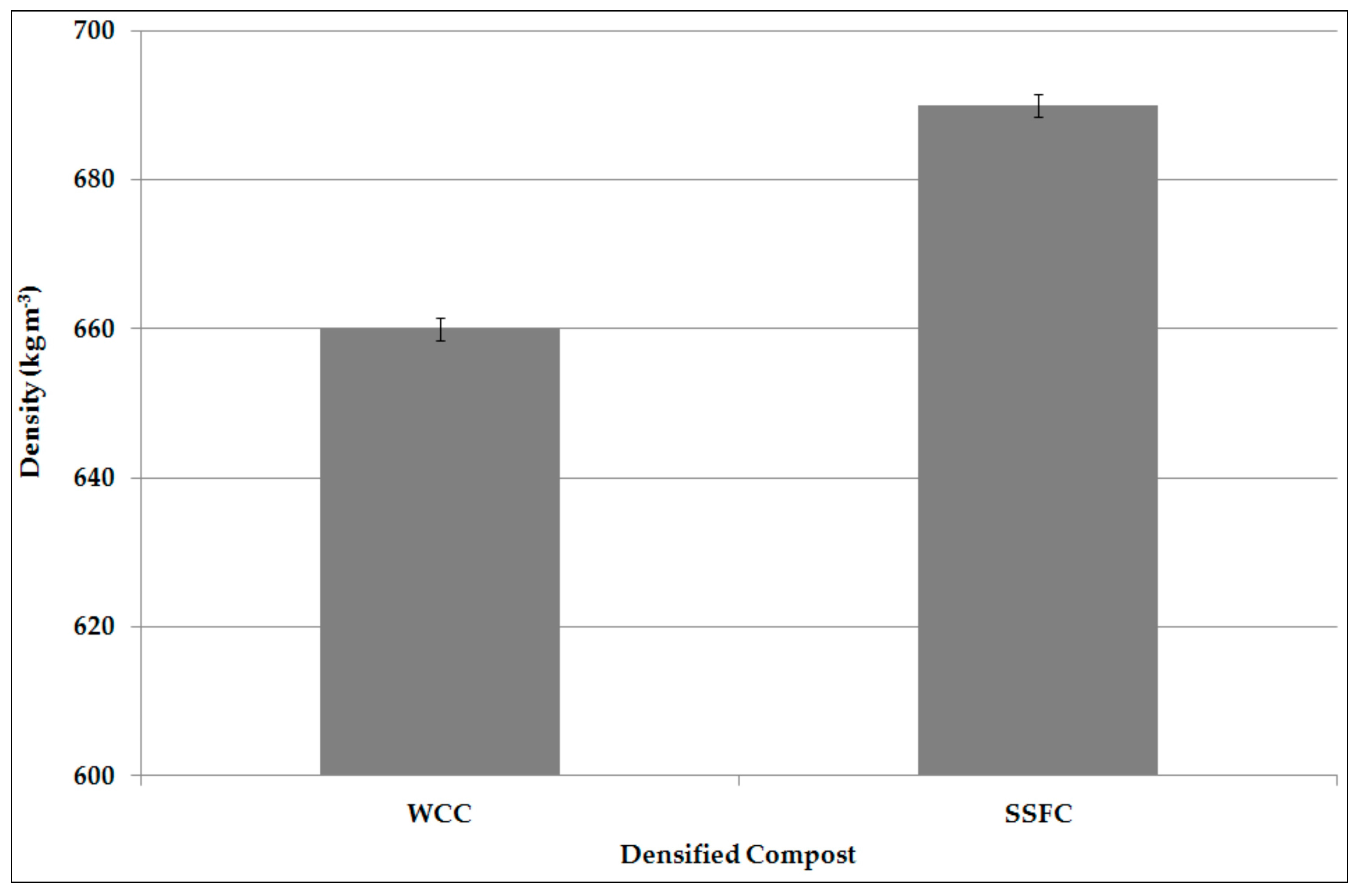
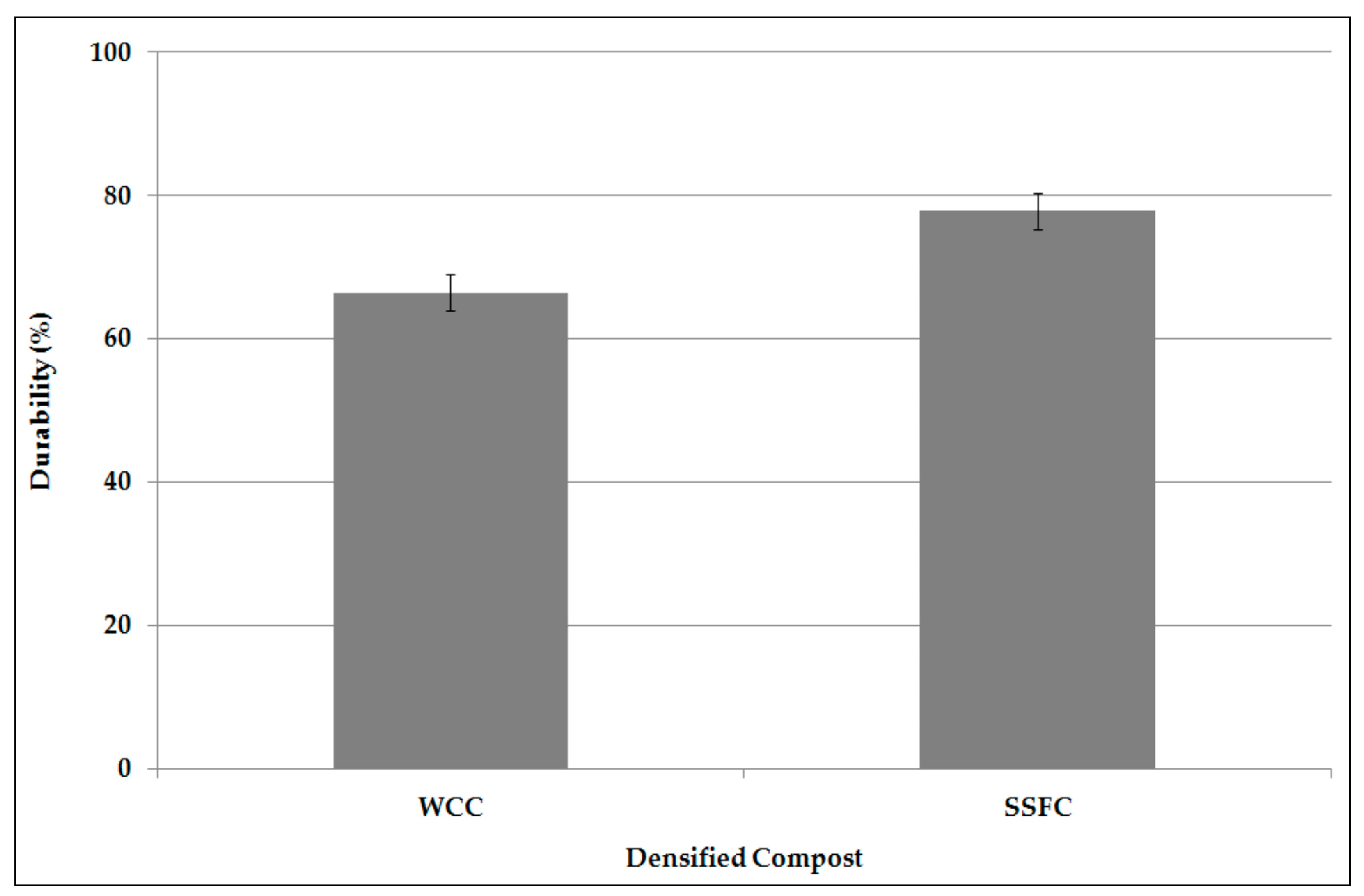
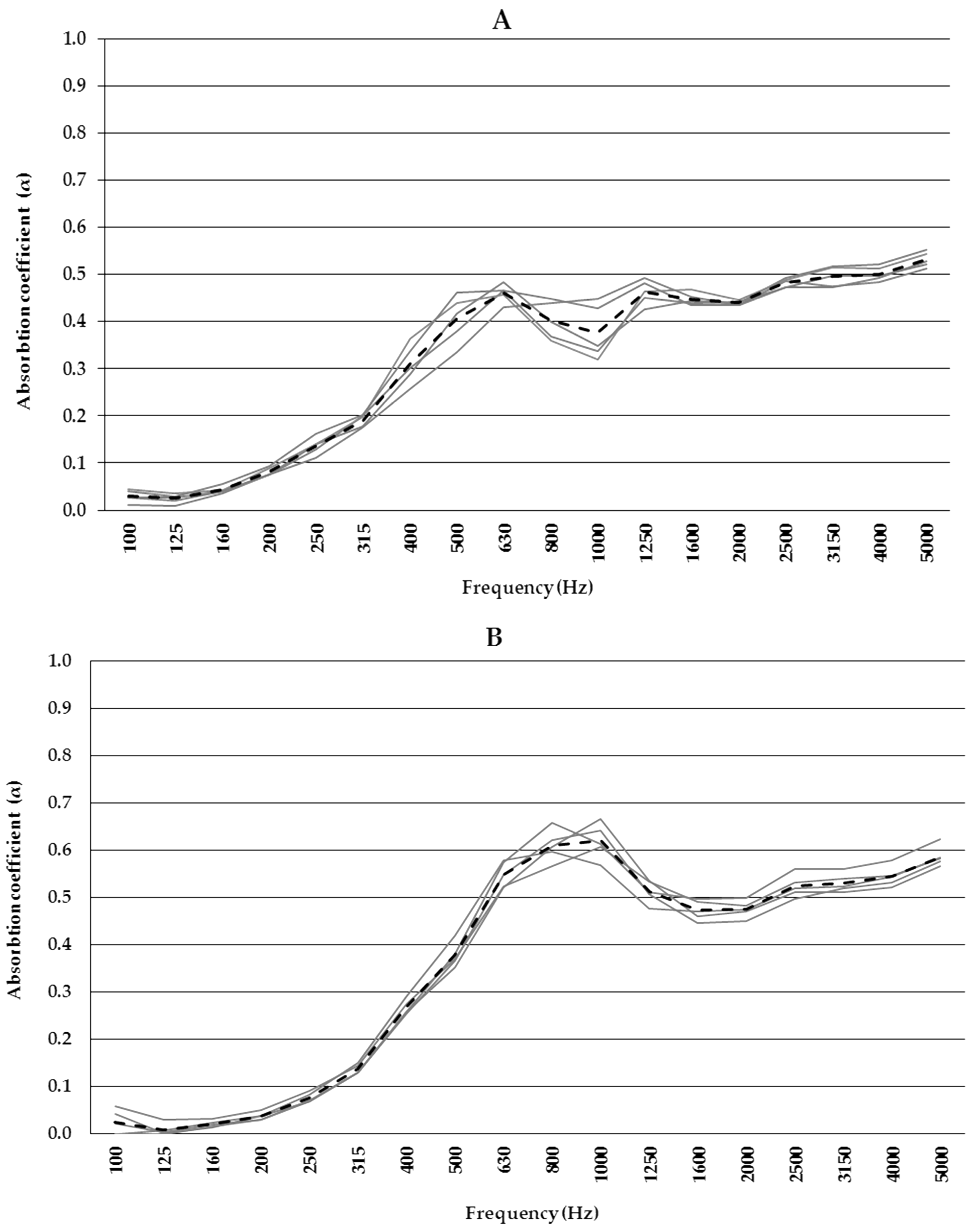
| Material | Thickness (m) | Frequency (Hz) | |||||
|---|---|---|---|---|---|---|---|
| 125 | 250 | 500 | 1000 | 2000 | |||
| Kenaf | (Dense) | 0.04 | 0.08 | 0.18 | 0.32 | 0.70 | 0.94 |
| Wood | (Fibers) | 0.06 | 0.20 | 0.40 | 0.50 | 0.65 | 0.91 |
| Wood | (Mineralized) | 0.03 | 0.05 | 0.10 | 0.10 | 0.20 | 0.40 |
| Hemp | 0.03 | 0.01 | 0.15 | 0.25 | 0.51 | 0.70 | |
| Coconut | 0.05 | 0.10 | 0.20 | 0.34 | 0.67 | 0.79 | |
| Cork | 0.03 | 0.01 | 0.02 | 0.10 | 0.30 | 0.86 | |
| Cane | (Mixed) | 0.04 | 0.05 | 0.10 | 0.35 | 0.54 | 0.58 |
| Cane | (Only wooden) | 0.04 | 0.01 | 0.06 | 0.12 | 0.47 | 0.43 |
| Cane | (Only bark) | 0.04 | 0.10 | 0.12 | 0.38 | 0.64 | 0.62 |
| Cardboard | 0.10 | 0.10 | 0.27 | 0.48 | 0.54 | 0.66 | |
| Sheep wool | 0.04 | 0.10 | 0.14 | 0.36 | 0.73 | 0.94 | |
| Sheep wool | 0.06 | 0.15 | 0.28 | 0.66 | 0.95 | 0.94 | |
| SSFC | 0.03 | 0.01 | 0.08 | 0.38 | 0.62 | 0.48 | |
| WCC | 0.03 | 0.02 | 0.14 | 0.41 | 0.38 | 0.44 | |
© 2018 by the authors. Licensee MDPI, Basel, Switzerland. This article is an open access article distributed under the terms and conditions of the Creative Commons Attribution (CC BY) license (http://creativecommons.org/licenses/by/4.0/).
Share and Cite
Pampuro, N.; Preti, C.; Cavallo, E. Recycling Pig Slurry Solid Fraction Compost as a Sound Absorber. Sustainability 2018, 10, 277. https://doi.org/10.3390/su10010277
Pampuro N, Preti C, Cavallo E. Recycling Pig Slurry Solid Fraction Compost as a Sound Absorber. Sustainability. 2018; 10(1):277. https://doi.org/10.3390/su10010277
Chicago/Turabian StylePampuro, Niccolò, Christian Preti, and Eugenio Cavallo. 2018. "Recycling Pig Slurry Solid Fraction Compost as a Sound Absorber" Sustainability 10, no. 1: 277. https://doi.org/10.3390/su10010277





